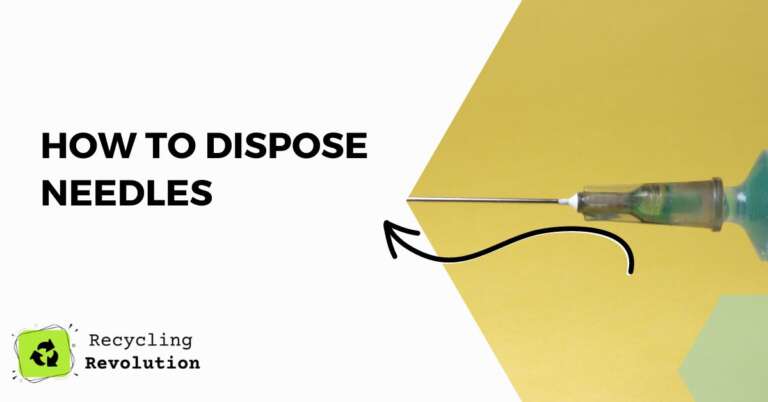Picture this: you’re enjoying a leisurely stroll through your local park when suddenly, you feel a sharp pain in your foot. Looking down, you see a discarded needle on the ground, and panic sets in.
You’ve just encountered one of the many risks associated with improper needle disposal. In this article, we will dive into the importance of safe needle disposal and the potential hazards of not following proper procedures.
Improper needle disposal can lead to needlestick injuries, the spread of infectious diseases, and environmental damage. Let’s explore how to avoid these dangers and keep ourselves and our communities safe.
Types of Needles and Sharps
Needles come in various shapes and sizes, including hypodermic needles, syringes, lancets, and surgical needles. Understanding the different types of needles and sharps is essential for proper disposal.
Potential Hazards and Health Risks
Used needles can carry blood borne pathogens, such as HIV, hepatitis B, and hepatitis C. Improper disposal increases the risk of needlestick injuries and the potential spread of these diseases.
Legal Regulations and Local Guidelines
Different regions have specific regulations and guidelines for needle disposal. It’s crucial to research and follow your local laws to ensure safe and legal needle disposal.
Safe Needle Disposal Methods
Community Disposal Programs
Many communities offer designated drop-off sites for disposing of needles and sharps. These programs provide safe, convenient options for proper disposal.
Medical Waste Disposal Services
Medical waste disposal services offer pickup and disposal of needles and sharps for households and businesses. This service is an excellent option for those who generate a large volume of needle waste.
Mail-Back Programs
Mail-back programs allow you to send used needles and sharps to a disposal facility via mail. These programs provide pre-addressed, postage-paid containers for easy and convenient disposal.
Home Needle Disposal
Needle Clipper Devices
Needle clippers are small, portable devices designed to safely remove and contain the needle portion of a syringe or lancet.
Sharps Containers
A sharps container is a puncture-proof, leak-resistant container specifically designed for the safe disposal of needles and sharps.
Guidelines for Using a Sharps Container
- Use only FDA-cleared sharps containers.
- Do not overfill the container.
- Keep the container out of reach of children and pets.
- Replace the container when it’s two-thirds full.
Needle Disposal for Travelers
Portable Sharps Containers
Portable sharps containers are a convenient option for travelers who need to dispose of needles and sharps while away from home.
Researching Local Regulations and Facilities
When traveling, it’s essential to research local regulations and facilities for needle disposal. This information ensures you’re following proper disposal procedures while on the go.
Step-by-Step Needle Disposal Process
Gathering Necessary Supplies
Before disposing of needles and sharps, gather the necessary supplies, including a sharps container or other approved disposal container, gloves, and any other required items.
Preparing the Disposal Area
Designate a clean, stable surface for needle disposal. This area should be free of clutter and easily accessible.
Safe Handling Techniques
Never touch needles or sharps with your bare hands. Use gloves, tongs, or a needle clipper device to handle needles and sharps safely.
Proper Placement in Disposal Container
Place the used needle or sharp directly into the disposal container without attempting to recap or bend the needle.
Sealing and Securing the Container
Once the container is two-thirds full, securely close the lid and ensure it’s sealed. Then, store it in a safe location until it’s ready for disposal.
Resources and Support
- Local Health Departments and Waste Management Agencies – Local health departments and waste management agencies are excellent resources for information on safe needle disposal. They can provide details on local regulations, disposal sites, and disposal services.
- Websites and Helplines for Information – Various websites and helplines offer comprehensive information on needle disposal. The FDA, EPA, and SafeNeedleDisposal.org are just a few examples.
- Community Programs and Events – Community programs and events often provide needle disposal services and educational resources. Keep an eye out for these opportunities in your local community.
Environmental Impact and Recycling
Recycling Programs for Needles
Certain areas offer recycling programs for needles and sharps. These programs are an eco-friendly way to dispose of needle waste, reducing the impact on landfills.
Needle Destruction Methods
Needle destruction methods, such as incineration, can effectively reduce the volume of needle waste. However, these methods should be conducted by trained professionals to ensure safety and compliance with environmental regulations.
Promoting Sustainability and Waste Reduction
By using safe disposal methods and participating in recycling programs, we can contribute to sustainability and waste reduction. Each small action adds up to a significant impact on our planet.
Conclusion
In this article, we’ve covered a lot of ground, from the importance of proper needle disposal to understanding needle waste, safe disposal methods, resources for support, environmental impact, and the importance of education and awareness.
Remember, safe needle disposal isn’t just a personal responsibility—it’s a community responsibility. By following these guidelines, we can keep ourselves, our loved ones, and our environment safe. We encourage you to take the information you’ve learned today and put it into action. Let’s work together to promote responsible waste management and create a safer, healthier world.
FAQs
How are needles discarded?
Needles should be discarded in a puncture-proof, leak-resistant sharps container. Once the container is two-thirds full, it should be sealed and taken to a designated disposal site or sent back via a mail-back program.
How are surgical needles disposed?
Surgical needles are disposed of in the same manner as other needles. They should be placed in a sharps container immediately after use, and the container should be properly sealed and disposed of when it’s two-thirds full.
What is the proper protocol for disposing of infectious waste?
Infectious waste, including used needles, should be placed in a designated sharps container. The container should be sealed when its two-thirds full and taken to a designated disposal site, or disposed of through a medical waste disposal service or mail-back program.

